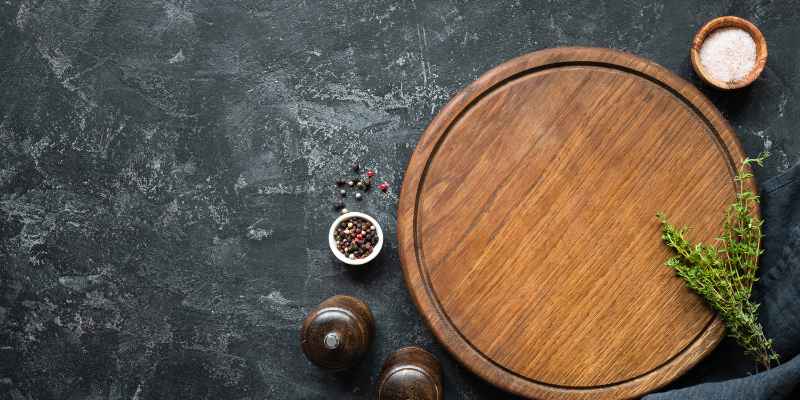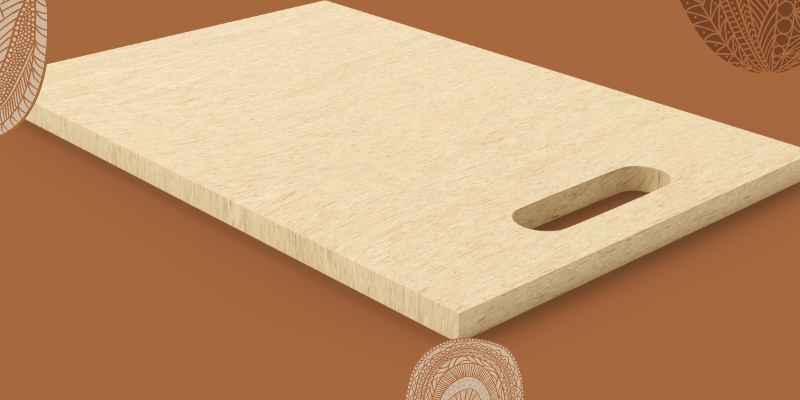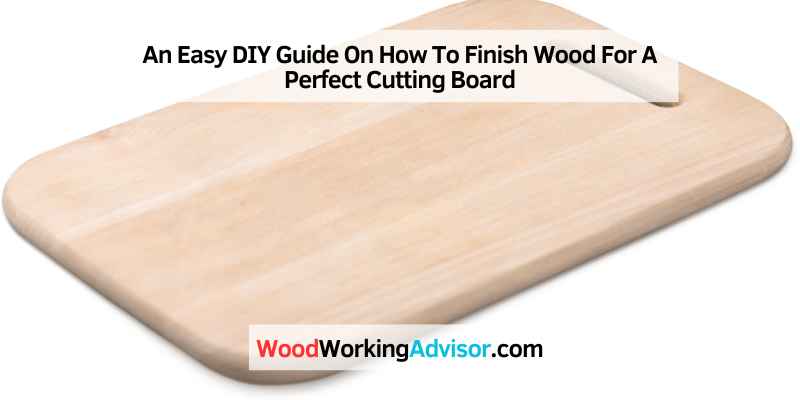To finish wood for a cutting board, you’ll need to sand the wood smoothly, then apply a food-safe finish. You can use mineral oil, Beeswax, or polyurethane. First, sand the wood with progressively finer grits of sandpaper until it’s very smooth.
Then, wipe off the dust with a damp cloth and let the wood dry completely. Next, apply a thin layer of your chosen finish to the board with a clean cloth, working in the direction of the grain. Let the finish soak in for at least an hour before wiping off any excess.
Finally, buff the board with a soft cloth to make it shine.

How to finish a wooden cutting board
- Cut the wood to size using a saw
- Smooth the edges of the wood with a sanding block or electric sander
- Apply a food-safe finish to the wood, such as mineral oil or beeswax
- Allow the finish to dry completely before using the cutting board
How to Finish a Cutting Board Food Safe
Like most people, you probably use a cutting board every day. But did you know there are right and wrong ways to care for your cutting board? It can become a breeding ground for bacteria if you don’t take the proper steps to clean and sanitize your board.
Here’s how to keep your cutting board food safe: The first step is to choose the right cutting board. If you’re using a wooden board, make sure it’s made of hardwood (like maple or cherry) that has been sealed with mineral oil.
Avoid softer woods (like pine) because they’re more likely to absorb bacteria. You can also use plastic or glass boards but clean them thoroughly after each use. Once you have the right cutting board, cleaning it properly after each use is essential.
Start by scrubbing the surface with hot, soapy water. Then rinse with clear water and let the board air dry or pat dry with a clean towel. If deep cuts or gouges are on the board’s surface, disinfect them with one tablespoon of bleach per gallon of water.
Let the solution sit on the affected area for at least 2 minutes before rinsing away with clear water. It’s also a good idea to sanitize your cutting board periodically – even if it looks clean! To do this, mix up a solution of 1 tablespoon bleach per gallon of water and soak the entire surface of the board for at least 2 minutes.
Rinse away with clear water and let air dry completely before using again. By following these simple tips, you can help keep your cutting board food safe – and prevent cross-contamination in your kitchen!
What is the Best Finish for a Cutting Board
When it comes to cutting boards, there are a few different options when it comes to finishes. You can go with the classic unfinished wood look or opt for something more flashy, like a bamboo cutting board. But what is the best finish for a cutting board?
Here are a few things to consider when deciding the best finish for your cutting board. The first is durability. You want to ensure that your finish will stand up to the wear and tear of daily use.
The second is hygiene. You want to ensure that your finish won’t harbor bacteria and other nasty stuff. And finally, you want to consider aesthetics.
After all, your cutting board will be in the open, so you might make it look good! So, considering all those factors, what is the best finish for a cutting board? We think it’s safe to say there is no one-size-fits-all answer here.
It depends on your individual needs and preferences. However, we will say that bamboo cutting boards are durable and easy to clean – making them an excellent option for those looking for the best of both worlds.
How Do You Seal a Wooden Cutting Board?
Sealing a wooden cutting board is a simple process that can help prolong the life of your board. By closing the wood, you are creating a barrier between the wood and moisture. This will help prevent warping, cracking, and staining.
You will need to purchase food-grade mineral oil to seal your cutting board. You can find this at most hardware stores. Apply the oil to your cutting board with a clean cloth, working it into the wood grain.
Be sure to cover the entire surface of the board. Allow the oil to soak in for at least 30 minutes, then wipe away any excess. Your board is now ready for use!
How to Finish a Cutting Board With Beeswax
A cutting board is a necessary item in any kitchen, and it should be made of durable material that can withstand constant use. Wood is famous for cutting boards because it’s solid and easy to clean. However, untreated wood can dry out and crack over time, so finishing it with a protective coating is essential.
Beeswax is a natural option that will help keep your cutting board looking new for years to come.
Here’s how to finish a cutting board with beeswax:
1. Start by sanding the cutting board’s surface with fine-grit sandpaper.
This will create a smooth surface for the beeswax to adhere to.
2. Melt the beeswax in a double boiler or microwave. Do not let it boil!
3. Once melted, brush the wax onto the cutting board’s surface with a clean paintbrush, covering all areas evenly.
4. Allow the wax to cool and harden completely before using the cutting board again.
How to Stain And Seal a Cutting Board
When it comes to culinary prep, a cutting board is one of the essential tools in your kitchen. Not only do you use it for chopping and slicing fruits, vegetables, meats, and cheeses, but a good cutting board can also help protect your countertops from knife marks. But what happens when your cutting board shows signs of wear and tear?
If your cutting board is made of wood, it’s time to stain and seal it. This will make it look new again and help protect the wood from moisture and bacteria.
Here’s how to do it:
1. Start by sanding down your cutting board with medium-grit sandpaper. This will rough the surface so the stain can penetrate the wood better. Wipe away any dust with a damp cloth.
2. Next, apply a thin layer of wood stain with a clean cloth or brush. Work in small sections and immediately wipe away any excess stains. Allow the paint to dry completely before moving on to the next step.
3. Once the stain is dry, apply 2-3 coats of food-safe mineral oil (available at most hardware stores).
What is the Best Finish to Put on a Cutting Board?
When it comes to cutting boards, the best finish to put on them is food-safe mineral oil. This will help protect the wood from water and stains while keeping the board looking its best. You can find food-safe mineral oil at most hardware stores.
What Finish Do You Put on a Wood Cutting Board?
When it comes to wooden cutting boards, the options for finishes are endless. You can choose a natural finish, allowing the wood grain to show through. You can also stain or paint your cutting board, adding a pop of color to your kitchen.
You can opt for polyurethane or varnish if you want a more durable finish. No matter what finish you choose, and your cutting board smoothly before applying any finish.
What Oil Do You Use to Finish a Cutting Board?
When finishing a cutting board, a few different oils can be used. The most common and recommended oil to use is mineral oil. This oil is food safe and will help to protect the wood from water damage and staining.
Other oils that can be used include olive oil or beeswax. These oils will need to be reapplied more often than mineral oil, but they will still help to protect the wood and keep it looking its best.

Do You Need to Finish a Wood Cutting Board?
If you’re using a cutting board made of wood, you don’t need to finish it. It’s best not to because the finish can become sticky and attract dirt and grime. If you choose to spend your board, use a food-safe mineral oil or beeswax.
Conclusion
Assuming you would like a summary of the blog post titled “How to Finish Wood for a Cutting Board,”: There are many ways to finish wood, but food-safe mineral oil is the best option for a cutting board. You can buy it at any hardware store.
Apply the oil with a clean cloth, working it into the surface of the wood in a circular motion. Let it sit for 15 minutes, then wipe off any excess. Repeat this process every few weeks, and your cutting board will last for years.



6 thoughts on “An Easy DIY Guide On How To Finish Wood For A Perfect Cutting Board”